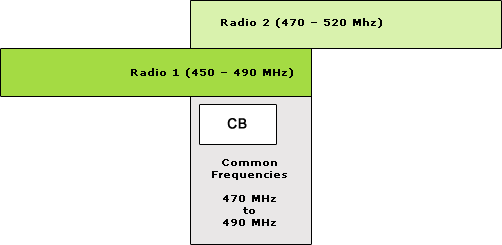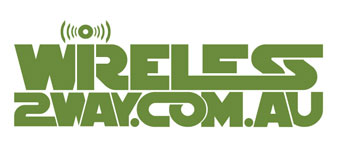The ‘What Should I Know?’ When Buying Two Way Radios
the two way radio purchase guide by wireless 2-way
The following is a brief overview of information we think you should know when buying two way radios. This by no means covers everything one could know before buying a two way radio as each individual has specific needs, but can be used as a two way radio purchase guide. This information has been written for Australian purchasers and may not be accurate for other parts of the world.
how far will my two way radio transmit?
Firstly the RF POWER OUTPUT is a main contributor to this, for this example we will be using examples of SIMPLEX radios in a CBD environment, where the two way radio signal has to travel through and around buildings.
So if a 4-Watt two way radio worked for example up to 3kms away, then mathematically, due to decrease in signal strength a 1-Watt two way radio would only work up to 1km away. This changes with each and every environment with different factors like line of sight and what the radio signals have to bounce off or penetrate etc, but at least this gives you an idea.
The second contributing factor of how far my two way radio will transmit is the frequency band you are on. Some frequencies are better at travelling distance where as others are better at penetrating for example concrete. A quick rule of thumb
- 800 MHz two way radios
Have good penetration through solid material (through concrete for example) - VHF two way radios
Have good long distance line of site coverage (on the open water for example) - UHF two way radios
Are a good general mixture of both penetration and distance.
Finally it is unfortunate to say but size does matter. The larger the two way radio antenna is, the larger the dispersion of the signal and therefore the range of the two way radio.
How do two way Radios communicate with each other?
The two most common ways that two way radios communicate are:-
In SIMPLEX: – This means that you talk radio to radio. The radio signal travels out of the antenna of the transmitting two way radio into the air, and if another two way radio is in proximity and on the same channel that the transmitting two way radio is on, then it will receive the incoming transmission.
OR
Via a REPEATER: – This means that the radio signal travels out of the antenna of the transmitting two way radio into the air, which is picked up by a signal booster (the repeater) which re-transmits the original signal to the receiving radios. Repeaters are used to boost the strength of a radio signal either inside a building where the signal needs to penetrate many layers or outside to extend the range of the two way radio. A repeater can only boost one channel, so you need an individual repeater per channel you want boosted.
All two way radios communicate within FREQUENCY BANDS; these frequencies are divided into various bandwidths (for radio) some of which are: –
- UHF – 450 to 520 MHz (CB channels 1 – 40 are between 476.425 and 477.460 MHz)
- VHF – 49.250 to 174 MHz
- 800 MHz Digital and Analogue Radios – Usually in the 800 MHz range either between 820 to 825 MHz or between 865 to 870 MHz.
will different two way radios talk to each other?
It is quite easy to have different types of two way radios talk to each other as long as the frequency range has some common frequency banding.
FOR EXAMPLE:- if one particular model of UHF two way radio has a frequency range of 450 – 490 MHz (Radio 1) and another model UHF two way radio has a frequency range from 470 – 520 MHz (Radio 2) then as long as the channels you want to use fall within these common frequencies (480 to 500 MHz in this example) then there is no problem at all. And in this example both of the individual two way radios are compatible with 40 channel CB radios.

Just to make things a bit clearer, you might look at the common frequencies above and say that there is only 20 MHz of common frequencies. This would translate to the following number of individual frequencies:-
20 X 80 (Freq/Meg@12.5k Spacing) = 1,600 individual frequencies
do i need to licence a frequency?
If people who do not want to obtain a frequency licence opt to have their two way radios programmed with channels in the CB frequency range, they are able to limit the general noise chatter on that frequency with what is like for lack of a better word an electronic key. This means that only two way radios on a particular frequency with the same electronic key are able to talk to each other. There are two main types of electronic keys.
PRIVATE LINE – Different manufactures have different names for this such as CTCSS, Tone, TPL or a PL, but they all mean exactly the same thing. This is a sub-audible tone that acts as the previously mentioned electronic key. There are 42 of these tones, so that means that there are 42 private lines per frequency.
That means for the CB range of frequencies (CB channels 1 – 40 are between 476.425 and 477.460 MHz) with 42 private lines per frequency (with 25k spacing) this means that there are 1,680 possible private lines available in the CB band.
DIGITAL PRIVATE LINE – This is also referred to as DPL. This is a digital version of the Private line as outlined above with 83 digital private lines per frequency. The additional benefit of digital private lines is that they can be, what is called inverted, creating an additional 83 inverted digital private lines bringing the total to 166 DPL’s per frequency.
That means for the CB range of frequencies with 166 Digital private lines per frequency (with 25k spacing) this means that there are 6,640 possible private lines available in the CB band.
Because PRIVATE LINES and DIGITAL PRIVATE LINES are different types of electronic key this gives you a total of a 1 in 8,320 that someone within the area that you are working will have the same programming, and therefore minimising the possibility of external parties chatter on your channels.
We hope this gives you a brief overview of how two way radios work and what to look for when purchasing two way radios, but if you have any further questions that we can help you with please feel free to contact our two way communication consultants on 1300 885 309 or via e-mail by visiting our contact page.
